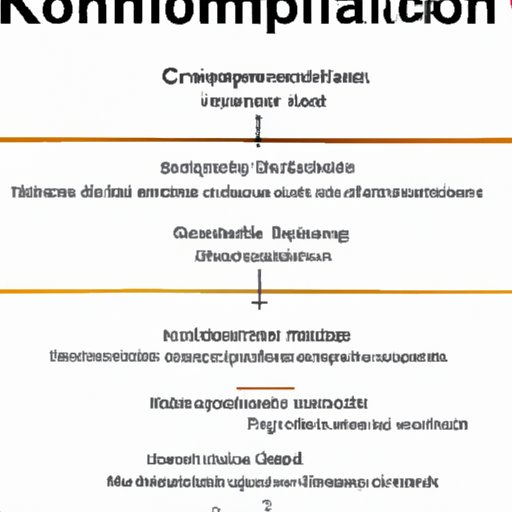Introduction
A kingdom is a major category used in science to classify and organize living organisms. Kingdoms are part of a larger system of scientific classification known as taxonomy. Taxonomy is the formal method used for categorizing and naming species. The purpose of this article is to explore the concept of kingdoms in science and examine their role in scientific classification.

Comparing Kingdoms in Science to Other Organizational Systems
In order to understand the role of kingdoms in science, it is important to first compare them to other organizational systems. The most common organizational system used in science is the Linnaean system of classification. This system was developed by Carl Linnaeus in the 18th century and is still widely used today. This system organizes species into seven hierarchical categories: kingdom, phylum, class, order, family, genus, and species. Each category is based on shared characteristics and is used to group related species together.
Another organizational system used in science is the cladistic system. This system uses phylogenetic trees to group species based on their evolutionary history. Unlike the Linnaean system, the cladistic system does not use hierarchical categories. Instead, it uses the branching structure of the tree to show how species are related.
When compared to these other organizational systems, kingdoms play an important role in scientific classification. They provide a large-scale view of the different groups of organisms and their relationships. By using kingdoms, researchers can quickly identify which species they need to study and what other organisms they may be related to.
Examining the Role of Kingdoms in Scientific Classification
The role of kingdoms in scientific classification is to provide a way to organize species into broad categories. In the Linnaean system, the kingdom is the highest level of classification. All other categories are nested within the kingdom. For example, a species may belong to the Animalia kingdom, the Chordata phylum, the Mammalia class, the Carnivora order, the Canidae family, and the Canis genus.
Kingdoms also provide a way to differentiate between different groups of organisms. For example, the Animalia kingdom contains all animals, while the Plantae kingdom contains all plants. This helps scientists easily identify which species belong to which group and how they are related.
Analyzing the Benefits of Utilizing Kingdoms in Science
Utilizing kingdoms has many benefits for scientists. One of the main benefits is that it allows for efficient organization of species. By grouping species into kingdoms, researchers can quickly identify which species they need to study and what other organisms they may be related to. This saves time and energy when conducting research.
Kingdoms are also beneficial because they help scientists accurately classify species. By using kingdoms, researchers can ensure that species are correctly grouped and named. This prevents confusion and inaccuracies in scientific classification.

Outlining the Current Structure of the Five Kingdoms in Science
Currently, there are five kingdoms in science: Animalia, Plantae, Fungi, Protista, and Monera. Each kingdom contains different types of organisms with varying characteristics. The Animalia kingdom contains all animals, such as mammals, birds, reptiles, amphibians, and fish. The Plantae kingdom contains all plants, such as trees, shrubs, herbs, and grasses. The Fungi kingdom contains all fungi, such as mushrooms, molds, and yeasts. The Protista kingdom contains all protists, such as algae and amoebas. The Monera kingdom contains all bacteria and archaea.

Investigating the History of Kingdoms in Science
The concept of kingdoms in science dates back to Ancient Greece. Aristotle was one of the first to propose a system of classification for living organisms. He divided organisms into two categories: plants and animals. This division is still used today in the Animalia and Plantae kingdoms.
The modern day taxonomies are based on the work of Carl Linnaeus. In the 18th century, he developed the Linnaean system of classification, which is still used today. This system introduced the concept of hierarchical categories, such as kingdom, phylum, class, order, family, genus, and species.
Exploring the Future of Kingdoms in Science
The future of kingdoms in science is uncertain. As technology advances, the ability to accurately classify species becomes easier. This could lead to a shift away from the traditional Linnaean system of classification. For example, some scientists are now utilizing genetic data to classify species, rather than relying solely on physical characteristics.
The implications of this shift are unknown, but it could lead to a more accurate and efficient way to classify species. It could also lead to new discoveries about the evolutionary history of species and our understanding of the natural world.
Conclusion
In conclusion, kingdoms in science play an important role in scientific classification. They provide a way to efficiently organize species and accurately classify them. There are currently five kingdoms in science: Animalia, Plantae, Fungi, Protista, and Monera. The future of kingdoms in science is uncertain, as technology advances and new methods of classification are developed.
(Note: Is this article not meeting your expectations? Do you have knowledge or insights to share? Unlock new opportunities and expand your reach by joining our authors team. Click Registration to join us and share your expertise with our readers.)
